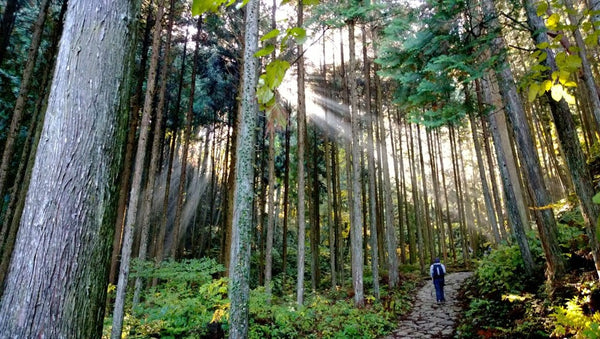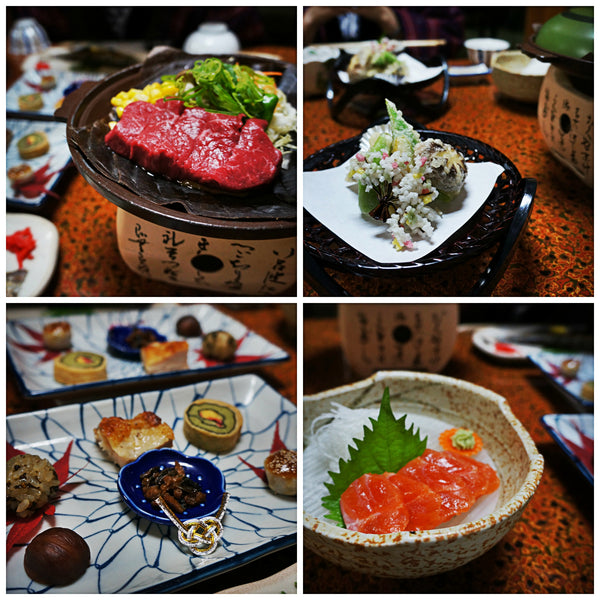Your Cart is Empty
Free Shipping on All Subscriptions Worldwide

There’s so much to see and do in Japan. The popular destinations of Tokyo and Kyoto are great, but there is so much more to Japan. “Off The Beaten Path” is a series that explores some of the lesser known yet amazing places in Japan. Our first stop was Nakasu (中洲), the hidden foodie mecca of Japan. Our second stop was Matsumoto(松本), a small and tranquil castle town at the base of the Japanese alps. For our third stop, we explore the ancient highway that was used by the samurais: Kiso-ji(木曽谷).

Tsumago
Everywhere you go in Japan, you see how the country preserves its ancient culture and history. As you travel the country, you start wondering what life would have been like back in the days of the samurai. How did they travel? What kind of places did they live in? What did they eat? Luckily, you can still get a feel for what life would have been like hundreds of years ago in the Kiso Valley.

Nakasendo depiction in ancient Japanese art
Japan had two ancient transportation routes to connect the major cities of Kyoto and Tokyo. The Tokaido, which ran along the southern sea line, and the Nakasendo (中山道), which ran through the mountains in central Japan. The Kiso Valley (70km) is part of the Nakasendo (500km), and is located in central Japan in the snowy Nagano Prefecture. The valley runs along the Japanese alps at the foot of Mt. Ontake, and is considered to be one of the most beautiful woodlands in Japan. But more importantly, the Kiso-ji road retains the scenery of the old days better than any place else in Japan.

Nakasendo path ©Mandala Travel
The Kiso-ji road first opened in 702 A.D. and later merged the larger Nakasendo Highway during the Edo period (1600s). Due to restrictions set by the ruling Shogunate, travelers were forced to make their trips on foot. As a result, many “post towns” developed along the highway to provide travelers a place to rest, eat, and stay. Among the 11 post towns situated on the Kiso-ji road, Tsumago, Magome and Narai are the best preserved and worth visiting.

Tsumago during the spring

Snow in Tsumago ©Yoshi Shimamura

Tsumago notice board - used to show proclamation from the shogunate ©David Esteban

Tsumago at dusk ©Adam Brill
Tsumago (妻籠) is the smallest of the post-towns, but arguably the most beautiful. It was relatively prosperous as a small trading town, but fell into obscurity and poverty after the completion of the national railway system. In 1968, the local residents began restoring and preserving the historical structures. Due to their efforts, the town is now considered a national treasure, and the townscape has been restored to that of the Edo Period (1600s). Walking around this town definitely brings you back to the days of the samurai with its unmatched serenity and beauty.
FREE GUIDE - 7 HIDDEN SNACK STORES OF TOKYO

Magome at night

Magome's many traditional inn where samurais would have stayed

Magome store front

Old water wheel that still works in Magome ©Colin_C

View from the top of Magome
 |
⛩ Discover Authentic Regional Snacks You Can Only Find in JapanExplore Snakku |
Magome (馬籠), situated on Mt. Ena, is the southernmost post town. The whole town is on the side of the mountain, and old-fashioned houses line the 600-m curving slope. Like Tsumago, the town fell into decay after the completion of the railway, but was revitalized in the 1960s.

Kiso-ji path

Along the Nakasendo path ©Bong Grit

Local resident's house along the Kiso-ji path. He invites you in for free tea and Japanese snacks ©Anaguma
Connecting Tsumago and Magome is a hiking trail, which is part of the original Kiso-ji/Nakasendo. It is 8km long and takes about 2-3 hours to complete but highly enjoyable, since it leads through the quiet countryside and gives you a sense of what traveling in old Japan was like. Watch out though, since there are bears in the area!

Narai during the winter

Delicacy around the Kiso Valley. Miso glazed sticky rice.

Local resident of the area

Inside one of the traditional inns where the shogun would have stayed ©raysII
Narai (奈良井), also known as “Narai of a Thousand Houses,” was the most prosperous post town in the valley. It is located exactly halfway between Kyoto and Tokyo and its historical houses are considerably larger than those in Tsumago and Magome.

Entrance to Fujioto Inn
Looking for a place to stay and experience the ancient hospitality of Japan? We recommend staying at the Fujioto Inn in Tsumago. They have amazing hospitality, a beautiful Japanese garden, delicious meals offering local delicacies, and a traditional Japanese wooden bath.

Inside the Fujioto Inn

One of Fujioto's rooms

Meal at Fujioto
If you liked this post, be sure to check out these other great articles about Japan!
Beautiful photos! Do you have any recommendations for a travel guide or tour to this area for non-Japanese speakers? I would love go visit.
@Lazyamble – hope you had a wonderful trip and were able to hike the trail. Also thanks for the tips; we’ll definitely check out those places and perhaps write about them too!
We had a tiring but yet fulfilling trip in Kiso Valley, it is the scenery that rewarded us. I also like to mention another place – towns hopping in Lake Biwa, our favourite Nagahama and Hikone.
@Sheri – thanks for the kind words! I hope you find all of our blog posts interesting. In regards to your luggage, luckily the towns have a carrier service which is available every morning between the two towns. If you drop of your luggage in the morning at the town center, they’ll bring it to the other town center for a very small fee. Let me know if you have any other questions :)
I just discovered your site. I’m in the middle of an ATW trip and planning a visit to Japan this spring. I really want to see the older historic towns like these. I’m a photographer and can’t wait to capture it all. Nice site, I’m going to have to search around and see what other great stuff is on here. I’m curious, when you did the hike between towns, what did you do with your luggage? Did you hike back the same day and keep your things in your lodging? Thanks!
Those pictures capture the scenery beautifully. They inspires me to go to Japan again. This time with a plan.
Whoa! Nice find!
This place is at the top of my bucket list. I don’t know why but I’ve always loved Oriental culture and history. Kiso Valley is exactly the kind of place I’ve envisioned visiting when I can eventually go to Japan. I don’t care for the city, it’s the temples and historic places like this that have my heart. Such beautiful sites and history.
I merely wanted to thank you one more time for that amazing blog you have made here. It is full of ideas for those who are definitely interested in that subject, primarily this very post.
Comments will be approved before showing up.
AlicevstheWorld
October 08, 2016
Oh wow, what an amazing place, I’d love to visit one day!